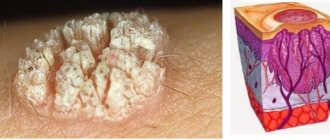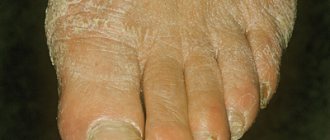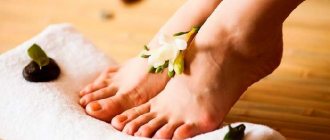Treatment of nail fungus with folk remedies: the best and most effective recipes
Onychomycosis is a difficult-to-treat fungal nail disease that nowadays affects every 5 people on the planet. For a healthy person, it is enough to walk barefoot on the beach or on the floor in a pool or water park for fungal spores to land on the surface of the nail plate. The infection can be treated in different ways, but folk remedies for nail fungus are rightfully considered the best in terms of safety for the body.
Almost all antifungal drugs have a toxic effect and negatively affect the functions of vital organs. Therefore, at the initial stage of the disease, folk remedies can be much more effective than synthetic drugs.
The use of folk recipes should be combined with strict adherence to hygiene measures, this will help prevent the further spread of infection and protect others from possible infection.
The best folk remedies against nail fungus
Folk remedies for toenail fungus can be combined with pharmaceutical medications prescribed by a dermatologist. The results of therapy in this case will be higher.
At home, onychomycosis is treated with herbs, foods and substances:
- Iodine.
- Vinegar.
- Onion.
- Coffee.
- Garlic.
- Propolis.
- Kerosene.
- Novocaine.
- Birch tar.
- Essential oils.
- Tea mushroom.
- Hydrogen peroxide.
- Apricot resin tincture.
Let's consider the most effective measures in the treatment of nail fungus with folk remedies.
Reviews from real people
Is it possible to cure nail fungus? What do people say about this?
Feedback on the forum
Feedback on the forum
Feedback on the forum
Feedback on the forum
Feedback on the forum
Feedback on the forum
Feedback on the forum
Feedback on the forum
Feedback on the forum
Feedback on the forum
There are a lot of reviews. But all people are sure that it is quite possible to cope with the fungus.
Tea tree oil
Choose quality essential oil. It doesn't have to be cheap. Only 100% oil will help. Usually there is a 10 ml bottle on sale. This amount will be enough for a whole year and there will be some left over.
Every night, use the pipette built into the bottle to place a drop on each nail. The liquid envelops the entire nail plate, the area around the nail and even the spaces between the fingers.
Dry your fingers in the open air. Wrap with gauze and put on cotton socks.
How to identify an infection
Onychomycosis is a fungal infection of the horny surface of the fingers. Clinical symptoms depend on the cause of the disease and the type of pathogen. Infection of nails with fungus is indicated by:
- cloudiness;
- white dots;
- thickening;
- delamination of the free edge;
- surface roughness.
At a late stage of the disease, the subungual and periungual spaces are affected. The skin becomes red, thins, peels, and swells. Onychomycosis is fraught with the addition of a bacterial infection. This is indicated by suppuration around the thumbnail.
Birch tar
You need to treat your nails with tar after steaming baths. This should be done 2 times weekly. A drop of pharmaceutical birch tar should be placed on the dry surface of each plate. Wait until the product dries, put on cotton socks and do not wet your feet for two days. Then repeat the procedure until improvement occurs.
You can also prepare an ointment. For one part of tar, take 4 parts of interior fat or baby cream, mix everything and apply it to your nails every day before bed. The fingers are wrapped in polyethylene, the bandage is secured, and socks are put on. In the morning, you can wash your feet with warm water and laundry soap.
You can also use tar soap, but there is not enough tar there, only 10%.
What determines the effectiveness of treatment?
To increase the effectiveness of nail treatment, it is recommended to use traditional recipes. However, they do not always lead to a positive outcome.
Please keep in mind in advance that even when carrying out home technologies for restoring the health of the coating, you need to pay attention to contraindications. The main one is individual intolerance. If you are allergic to a component, its use in the fight against fungus will not lead to a good result.
In addition, the effect after manipulation depends on the initial state of the natural manicure. If the girl had an advanced stage of damage, which implies the prescription of internal and external medications, home remedies will not bring results.
The result also depends on the type of fungus, since some pathogenic organisms lead to the appearance of inflammatory processes in the body, which can only be eliminated by taking antifungals.
Propolis
Propolis for fungus relieves itching, inflammation, and also prevents the development and spread of infection. With proper treatment, the diseased nail will fall off and a healthy one will quickly grow in its place.
- We take an alcohol tincture of propolis (20%) from the pharmacy, soak a cotton swab and apply it to the affected nail. After this, bandage the cotton wool and leave it for 1 day. After 24 hours, we repeat the procedure, having first scraped off the top softened layer with a file.
- The infection can be treated with propolis, which is crushed and mixed with antifungal ointments and creams. After which these medications are used according to the instructions. This will help enhance the therapeutic effect of medications.
- Twice a day, thoroughly steam your feet, cut off the affected areas of the nail, peel off the top layer and apply a piece of propolis to the treated surface. Leave it on your leg for 30 minutes. Within a month you will be able to see a positive result.
- Propolis tincture can be added to medicinal foot baths at the rate of 15 drops per 3 liters of water. Keep your feet in such a bath for 15-20 minutes, after which it is recommended to wipe your nails and feet dry, and lubricate the skin around the nail plate with hydrogen peroxide.
Correct implementation of the recipes guarantees the complete disappearance of nail fungus after 3 months.
Homemade ointments
Ointments prepared independently help with mycosis well. The recipes are as follows:
- Remove a tablespoon of cream from the milk, add an egg and 100 g of birch tar. Mix, apply to feet and bandage. Do it before bed.
- Spruce needles are crushed and placed in a 250-gram glass jar in 1 cm layers (needles + butter) to the very top. Cover the container with foil and simmer in the oven on low heat for 6 hours. After cooling, the mixture is filtered and cooled. Lubricate the feet with the resulting oil 3 times a day. No need to bandage. The effect occurs after the second application.
Celandine
I present the treatment of foot fungus with folk remedies with the indispensable help of celandine, which has a general, effective antifungal effect. In the summer, we pick the celandine, at the place of the breakdown the orange juice we need will appear (maybe with a tint). With this same juice, we lubricate all existing sick and affected areas.
You may feel itching at first, but it will certainly begin to gradually disappear. This procedure should be repeated after 3.5 minutes. Thus, we repeat exactly 4 necessary times. It is important to do 2 such cycles during the current day. A month of treatment will bring huge changes and improvements.
Causes of the disease
It happens that when a fungal infection gets on the skin or in the body of a healthy person, he does not get sick. Why is this happening? The immune system, which fights foreign microorganisms, saves you from illness.
In order for the pathogen to take root and begin to multiply, causing symptoms of nail fungus, one of the following factors must usually be present:
- Reduced immunity, immunodeficiency states;
- Vascular diseases in which the blood supply to the fingers deteriorates.
- Diabetes.
- Damage and trauma to the nail.
- Poor quality tight shoes
- . Increased sweating of the feet.
Symptoms of fungal infection include:
- Itchy feeling
- The appearance of an unpleasant odor in the affected areas
- Delamination of the nail plate
- Darkening of the nail, appearance of uncharacteristic coloring
- Swelling and swelling in the affected area
- Skin soreness (this sign is not always found and can be a serious symptom).
Most often, adults from 16 to 75 years of age are susceptible to the disease. Fungus (especially foot fungus) can be “picked up” in a public bath, in a swimming pool, a water park, and even in a beach locker room.
The intact foot of a healthy person upon contact with a pathogen is most often not affected by the fungus, since the protective properties of the skin are triggered, but with reduced immunity, age-related skin changes, mechanical damage to the skin and diseases of the thyroid gland and gastrointestinal tract, the risk of becoming infected with the fungus increases significantly.
However, if you are unable to visit a doctor, do not neglect the methods described below - and you may be able to cope with fungal infection at an early stage.
So, let's study the most effective ways to treat fungus that appears on the fingernails and toenails using folk remedies.
Vinegar
The fungus is destroyed by an acidic environment, so vinegar is widely used for treatment; with its help, you can quickly get rid of the infection, relieve inflammation of the skin, and also restore the structure of the nail.
- For treatment, you need to prepare a vinegar solution in the proportion of 1 part vinegar to 8 water. In this case, the liquid should be at room temperature. Before treatment, feet should be steamed in hot water, and then the affected part of the nails should be removed. Then you should dip your feet in a basin with the prepared vinegar solution for 15 minutes. This procedure is carried out once every two days.
- Another way is to soak clean socks in a vinegar solution, put them on your feet, put woolen socks on top and go to bed like that. In the morning, feet should be rinsed with cool water and dried thoroughly. Clean the softened surface of the nail with a file and treat with an antiseptic solution.
If desired, you can add essential oils to the water, such as peppermint, rosemary, lavender and eucalyptus oil. They have a relaxing, anti-inflammatory and antiseptic effect and allow you to destroy fungal spores in a short time.
What is foot fungus and ways of infection?
Mycosis or dermatomycosis is an infectious lesion of the skin of the feet, interdigital areas, fingers, and nails. Fungal foot infections primarily occur in cultures where it is customary to wear closed shoes most of the time. More often, the disease affects the elderly and people with weakened immune systems due to some serious pathology (immunodeficiency, pemphigus, diabetes mellitus, poor circulation in the extremities, and others).
The causative agents of fungal infections parasitize in the stratum corneum of the skin. They produce enzymes that break down keratin. Their cell walls (shells) contain mannan substances, which suppress local immunity and contribute to the development of a chronic inflammatory process on the skin. Among the numerous pathogens of mycosis, the main ones are Trichophyton rubrum, Trichophyton mentagrophytes, Epidermophyton floccosum.
You can become infected with a fungus in two ways: direct or indirect. The first infection option has several versions:
- close contact with a sick person;
- contact with an infected animal;
- through plants with which the sole comes into contact;
- through the soil in which the pathogen lives.
The indirect route of infection with mycosis of the foot occurs:
- when using household or personal hygiene items belonging to a sick person;
- when using objects that have been touched by an infected animal.
Symptoms of the disease
Depending on the type of fungus, specific symptoms of the disease are distinguished. For example, dermatophytes do not manifest themselves for a long time, penetrating deeply into the layers of the skin or under the nail bed. If the causative agent of mycosis is trichophytosis, then signs of infection are immediately visible - the yeast-like microorganism causes inflammation on the nails and skin, destroying tissue in a short time. It is difficult for even an experienced dermatologist to tell what type of infection a patient has without laboratory tests.
At the early stage of the disease, there are common symptoms of foot fungus:
- cracks on the sole;
- itching, burning, dryness, peeling of the skin;
- unpleasant foot odor;
- discoloration and brittleness of nails;
- glossy skin surface;
- thickening and redness of the epidermis;
- increased sensitivity of the sole;
- the appearance of fluid-filled blisters at the site of inflammation.
Forms of fungal infection
External manifestations of the fungus depend not only on the type of pathogen, but also on the degree of involvement of the skin, nails, and hair on the legs in the inflammatory process. Dermatologists distinguish the following forms of mycosis of the feet:
- Squamous form (scaly). At the initial stage, redness and peeling of the skin are observed. The affected areas have different areas.
- Hyperkeratotic stage. Severe coarsening of the sole, deep cracks on or near the heels. Both legs are affected simultaneously.
- Intertriginous form. It is considered the most common. It affects the area between the 4th and 5th toes, and less commonly develops between the 3rd and 4th toes. The cracks are replaced by erosions that begin to become wet, causing itching and burning. Streptococci penetrate into the loose tissue structure, causing pustular inflammation.
- Dyshidrotic form. Watery blisters that appear on the epidermis merge. After they disappear, extensive ulcers appear. Mycosis spreads to the hands.
Soda paste
To form a thick mixture, you need to dilute the required amount of soda with water. Then mix it all thoroughly until a homogeneous mass is formed. This paste should be applied in an equal layer to the nail, then drop a few drops of lemon juice on top of the soda.
As a result, it will pinch a little and characteristic bubbles will form. After 5 minutes, the paste should be removed by washing your feet with warm water and soap. When treating nail fungus with soda, you must use antifungal ointments.
Baths for foot fungus - instructions for use
The main temperature of the fungus bath should be no more than +40 degrees. Usually, with a fungus, a person’s immunity is weakened and too low or high temperatures are stressful for the body. True, this law does not work if the patient has chronic diseases: hypertension, tumors, varicose veins and blood clots. In this case, baths should be taken in water not exceeding +28 degrees.
It is important to adhere to the following rules before using the baths:
- During the treatment of the fungus, it is necessary to treat all shoes for infection, as well as boil tights, socks and other clothing that may have touched the affected areas;
- It is necessary to ensure that family members do not use the hygiene products of an infected person. These are things such as: slippers, towels, washcloths, pumice stones, etc.
- While taking a bath, you need to remove the largest keratinized areas of the feet; thickened areas of skin are removed using salicylic petroleum jelly. It should be applied to the feet in the morning and evening, and the scales should be removed with pumice;
- After the bath, you need to thoroughly dry your feet and change your socks. Removing moisture from the nail plate and feet prevents the proliferation of microorganisms.
- All instruments used during the bath must undergo antifungal treatment.
- After the bath, creams containing antibiotics should be applied to the feet to reduce inflammation.
Quick treatment of fungus with hydrogen peroxide
To quickly suppress the activity of the fungus that has invaded the nail plates, external use of hydrogen peroxide according to the Neumyvakin method is allowed.
- To treat onychomycosis, the professor recommends steaming your feet in a soda solution (1 teaspoon per 1 liter of water), and then “biting off” a small part of the affected nail with nail clippers. Next, a piece of cotton wool should be soaked in a 3% peroxide solution and applied to the nail area of the finger.
- For fungus on the hands, keep this application for 10-15 minutes, on the feet - from 40 to 60 minutes. The frequency of sessions is 2 per day until complete recovery. Baths for hands and feet for onychomycosis with hydrogen peroxide are made from water heated to 50°C and 3% peroxide. Ratio – 2 tbsp. l. x 1 liter of water. Limbs soar 2 p. per day for 15 minutes. during the week.
Peroxide can also be mixed with other substances to obtain effective folk remedies for the treatment of nail fungus:
- Half a cup of slaked soda is dissolved in 4 cups of water and a quarter cup of hydrogen peroxide 3% is poured in. Add half a cup of magnesium sulfate and a quarter cup of vinegar to the mixture. Saturate a cotton swab with the drug and fix the lotion with a band-aid on the affected plate. Change the bandage every 10 hours. The general course of therapy is 1 month.
- Vinegar is mixed with peroxide (the concentration of both substances is 3%) in equal proportions. While the mass sizzles, your feet are immersed in it. Next, the fingertips are placed for half a minute in bleach diluted with water, and the limbs are quickly washed under a running stream. The procedure is completed by treating the nails with a mixture of Vaseline and tea tree oil (1:1) and putting on warm socks. Treatment lasts 1 week.
Lotions with Novocaine will help you quickly and easily remove fungus from your nails. A piece of cotton wool is soaked in liquid medicine and tied to the affected plate. Just 2 lotions - and nail fungus is cured forever.
Pathogens of mycosis
The appearance of foot fungus is caused by yeast bacteria and fungi. Among the most common pathogens are the following:
- Trichophyton interdigital - due to this type of parasitic fungus, small cracks appear on the heels and peeling of the skin between the toes. Over time, advanced cases can lead to itchy blisters and swollen feet.
- Trichophyton Red is a fungus that causes rubrophytosis. First, the skin of the feet thickens, later scales appear on it, and the disease itself moves to the nail plates and affects them, leading to atrophy and rejection.
- Candida Albicans is a fungus that most often affects women. With thrush of the feet, skin sloughs and redness forms underneath. Erosion and cracks are painful.
A qualified dermatologist can determine what type of pathogen provoked the appearance of mycosis. You should pay attention to the condition of the skin of your legs and take the necessary measures in case of pathological changes.
Visitors' recipes
Vyacheslav. I want to share a method that helped me. The nail on my big toe was almost completely destroyed by the fungus, and then only I took it on. I prepared a mixture (medicine) from 3 tbsp. spoons of acetic acid (96%) + tbsp. spoon of vodka + tbsp. spoon of glycerin. The medicine should be stored in sealed dark glass containers. Before applying this medicine to the nail, you must thoroughly wash your feet and clean the loose part of the diseased nail so as to expose the remaining part of the nail as much as possible.
Dry your feet, especially the diseased nail, until the moisture is completely removed (the skin and nail must be completely dry, otherwise the fungus has a chance to stay alive longer). Then, using a cotton swab on a match or an ear stick, generously moisten the sore spot on the finger. It is best to do this in the evening, after returning home for the night or on the weekend. Without shoes and socks, the treatment effect will be maximum.
Along with this medicine, keeping your feet in the fresh air and especially in the sun helps very well!! My treatment lasted about 6 months. Therefore, you need to be patient. It all ended with complete relief from the fungus on my toenail. And most importantly, I did not take any pills or drugs internally!
In addition to external treatment, it is necessary to rethink your behavior and understand the moral and psychological reasons that contributed to the onset of the disease. It seems I managed to do this and, having realized the mistakes (sins) made in my behavior, I said goodbye to the effect and cause of the fungus together...
Prevention
To protect yourself from infection, you must:
- Use medical disinfectants with the inscription GOST;
- Keep your feet and nails clean;
- Take care of shoes, dry them, disinfect them;
- If your feet sweat a lot, treat them with antiperspirants;
- Wear comfortable shoes made from natural, breathable materials;
- In the sauna, swimming pool, gym locker room, wear rubber slippers;
- Do not use manicure tools, shoes or towels from strangers.











